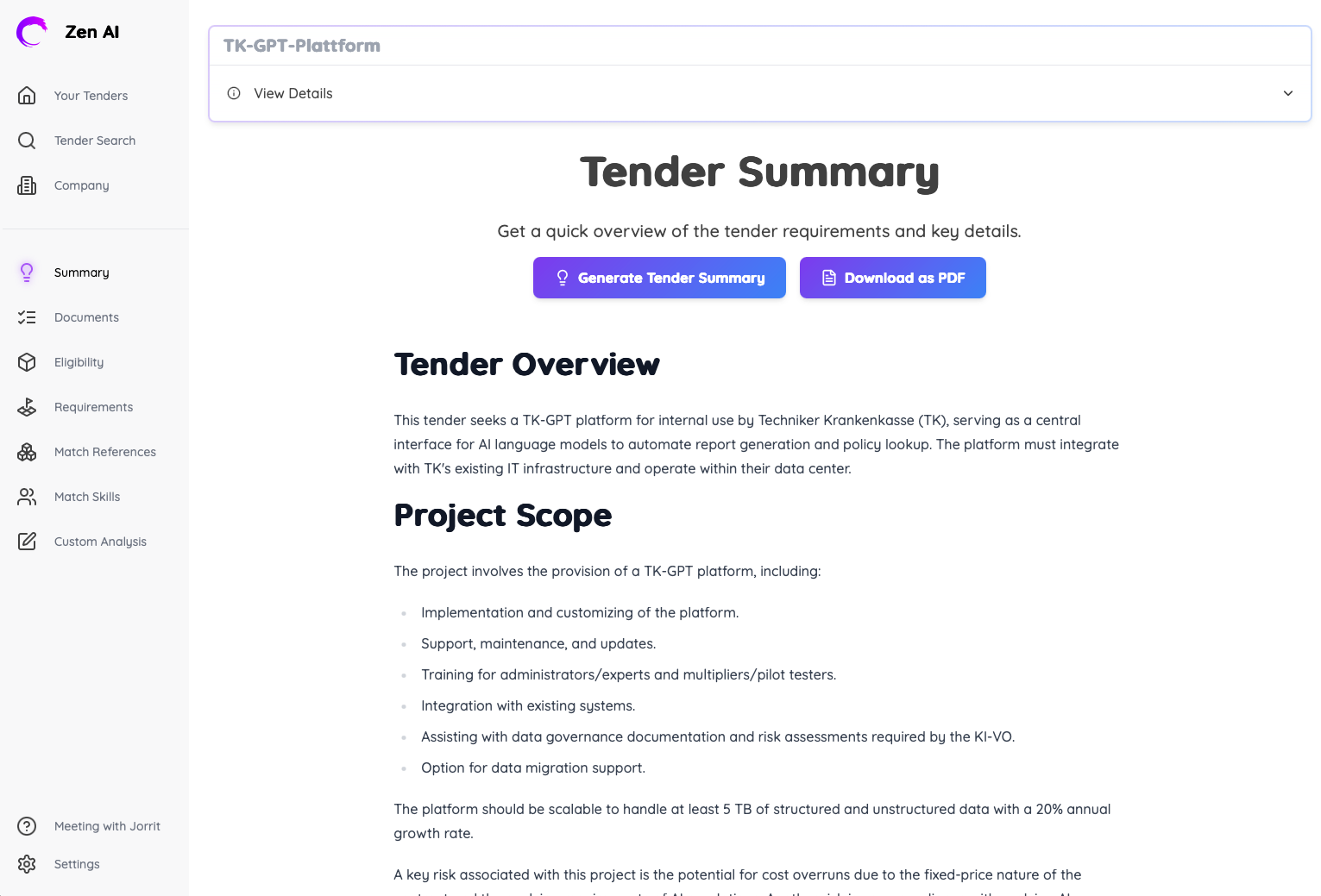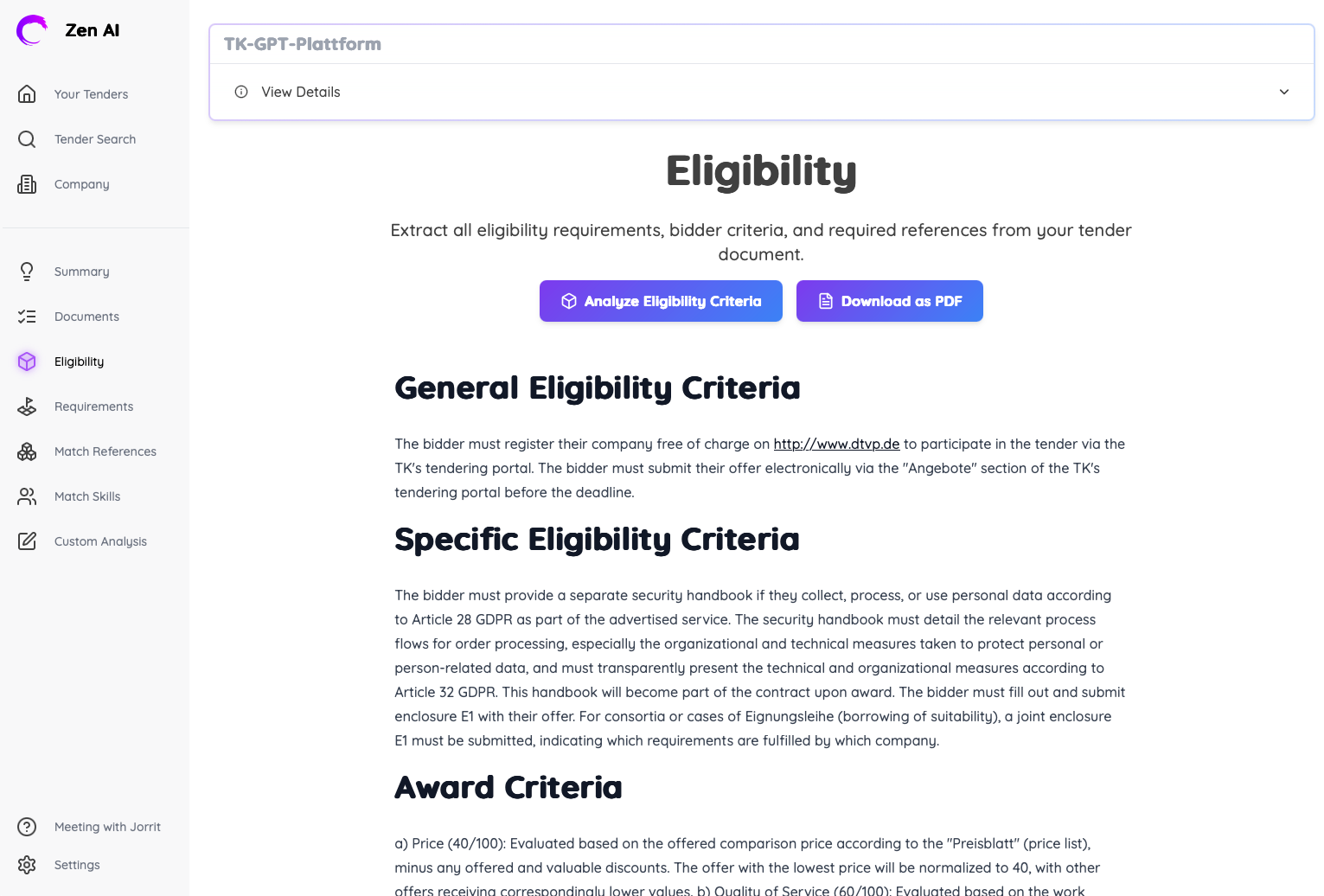Bid/No-Bid Analysis
The Bid/No-Bid Analysis feature helps you make informed decisions about which opportunities to pursue. This guide explains how to use this powerful tool to evaluate tenders and determine if they're worth your time and resources.
Understanding Bid/No-Bid Analysis
Making the right decision about which tenders to pursue is critical for business success. Every opportunity has costs associated with it—not just the direct costs of preparing a proposal, but also the opportunity cost of resources that could be directed elsewhere. Pursuing the wrong opportunities can waste valuable resources, while missing good opportunities can cost you potential revenue.
The Cost of Poor Bid Decisions
Poor bid decisions can significantly impact your business in several ways:
- Wasted Resources: Pursuing opportunities with low win probability consumes valuable time and resources
- Reduced Win Rate: Diluting your efforts across too many opportunities can reduce overall quality and success rate
- Opportunity Cost: Resources tied up in poor-fit opportunities aren't available for better prospects
- Delivery Challenges: Winning projects that don't align with your capabilities can lead to delivery problems
- Reputation Risk: Failed projects or withdrawn bids can damage your reputation in the market
Benefits of Structured Analysis
Zen AI's Bid/No-Bid Analysis helps you:
- Objectively evaluate tender opportunities using consistent criteria
- Identify strengths and weaknesses in your position relative to the opportunity
- Assess competitive factors that might impact your chances of winning
- Evaluate risks and requirements that could affect delivery
- Make data-driven decisions based on multiple factors
This objective approach helps overcome the biases that often affect bid decisions, such as optimism bias (overestimating your chances of winning) or sunk cost fallacy (pursuing opportunities because you've already invested time in them).
Accessing the Bid/No-Bid Analysis
To access the Bid/No-Bid analysis:
- Navigate to your Opportunities dashboard where all your current opportunities are displayed
- Select the opportunity you want to analyze by clicking on its name
- In the opportunity details view, click on "Summary" in the Analysis section of the sidebar
- If no analysis exists yet, you'll see a button to initiate the analysis
- Click the "Generate Tender Summary" button to start the process
- The system will process the tender documents and generate a comprehensive summary that includes key information for your bid/no-bid decision
- This typically takes 2-3 minutes depending on the size and complexity of the documents

How the Analysis Works
The Bid/No-Bid analysis uses a sophisticated AI-driven approach:
- Document Processing: The system analyzes all tender documents to extract key information
- Requirement Identification: Critical requirements are identified and categorized
- Profile Matching: Your company profile is compared against the requirements
- Competitive Assessment: The competitive landscape is evaluated based on tender characteristics
- Risk Identification: Potential risks and challenges are identified
- Scoring Algorithm: Multiple factors are weighted and combined to generate an overall recommendation
This comprehensive approach ensures that all relevant factors are considered in a consistent, objective manner.
During processing, Zen AI analyzes all uploaded tender documents, extracting key information and evaluating various factors that impact your potential for success. The AI considers both explicit factors (stated requirements, deadlines, evaluation criteria) and implicit factors (competitive landscape, alignment with your capabilities).
Eligibility Analysis
A critical part of the bid/no-bid decision is determining whether your company meets the basic eligibility requirements for the tender. Zen AI provides a dedicated eligibility analysis feature to help you with this assessment:
- Navigate to the opportunity details
- Click on "Eligibility" in the Analysis section of the sidebar
- Click the "Analyze Eligibility Criteria" button to initiate the analysis
- The system will process the tender documents and extract all eligibility requirements

As shown in the screenshot, the eligibility analysis provides a structured breakdown of all qualification requirements, including:
General Eligibility Criteria: Basic requirements for participating in the tender, such as registration requirements on specific portals (e.g., "The bidder must register their company free of charge on http://www.dtvp.de") or submission procedures through tendering portals.
Specific Eligibility Criteria: Technical, financial, or organizational requirements that bidders must meet, such as providing a security handbook for GDPR compliance or submitting specific enclosures with the offer.
Award Criteria: How proposals will be evaluated and scored, including the weighting of different factors. For example, the screenshot shows a tender with price weighted at 40/100 points and quality of service at 60/100 points, with a specific formula for calculating the total score.
Required References: Specific past project experience that bidders must demonstrate, such as implementation of model-agnostic GPT solutions with specific client characteristics.
Staff Requirements: Qualifications or certifications required for key personnel (if specified in the tender).
This analysis helps you quickly determine if you meet the minimum requirements to participate in the tender, saving you from investing time in opportunities where you would be automatically disqualified. It also highlights areas where you might need to gather additional documentation or partner with other companies to meet all requirements.
For each requirement, the system provides:
- A clear description of what's required
- The source document and location where the requirement was found
- The level of importance (mandatory vs. preferred)
Review this information carefully before proceeding with your bid decision. If you don't meet mandatory eligibility criteria, it's usually best to pursue other opportunities unless you can address the gaps through partnerships or other means.
